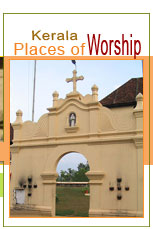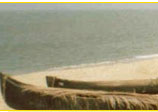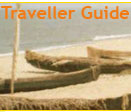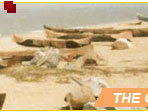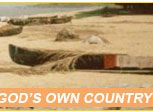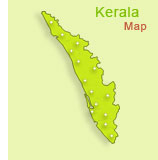¤¤ Tourist Attractions
Pazhassiraja Museum and Art Gallery (5 km from Kozhikode) On display here are copies of ancient murals, antique bronzes, old coins, excavated earthenware, models of temples, megalithic monuments like dolmonoid cysts, umbrella stones etc. Adjacent to the museum is the Art Gallery which exhibits and excellent collection of paintings by Raja Ravi Varma and Raja Raja Varma.
Krishna Menon Museum This museum has an exclusive wing dedicated to the late V L Krishna Menon, renowned statesman. His personal belongings and souvenirs are displayed here.
Kalipoika (2 km form Kozhikode): One can leisurely cruise on the dappled waters at Kalipoika in both pedal and row boats. Boating time: 0800-1900 hrs.
Kallai This was once the second largest timber trading centre in Asia. A steel bridge built by the British is still intact here.
S M Street Sweet Meat Street is the busiest street in Kozhikode and derives its name form the times when the street was lined with sweetmeat stalls.
Kirtads (7 km from Kozhikode) This unique museum houses the tools and devices used by the ancient tribal communities of Kerala. A good library with books on Anthropology and Sociology is an added attraction.
Beypore (10 km south of Kozhikode Located at the mouth of the Chaliyar river, Beypore, one of the prominent ports and fishing harboursof ancient Kerala was an important trade and maritime centre. Ancient Beypore was much sought after by merchants from Western Asia, for its shipbuilding industry. The boat building yard here, famous for the construction of the Uru (the Arabian trading vessel), boasts a tradition of almost 1500 years.
Kappad (16 km from Kozhikode): This is the historic beach where Vasco da Gama landed on the 27th of May 1498, with 170 men in three vessels. A monument on the beach commemorates this historic event. The rock studded beach is locally known as Kappakdavu. An interesting feature of the landscape is the sprawling rock that protrudes into the sea. The temple on the rock is believed to be 800 years old.
Kozhikode Beach This beach is a favourite haunt of sunset viewers. Adding to its natural beauty is the old world charm retained in the old lighthouse and the two crumbling piers, each more than a hundred years old, that run into the sea. Entertainment facilities such as the Lions Park for children and the marine water aquarium are added attractions.
Velliyamkallu This massive rock, much dreaded by navigators, was once a vantage point for the Marakkars to attack the invading Portuguese. An entire crew of a Portuguese ship was killed here. The beautiful natural engravings on the rock are worth exploring.
Thikkoti Lighthouse The lighthouse which overlooks Velliyamkallu off Moodadi coast was built after a shipwreck, the remains of which can still be seen here. The region around the Velliyamkallu rock is the transit home of migratory birds.
Payyoli This is yet another beautiful stretch of golden sands with shallow waters that border Velliyamkallu.
Kadalundi Bird Sanctuary (25 km from Kozhikode) The estuary at Kadalundi is a heaven for migratory birds. Terns, gulls, herons, sandpipers, whimbrels and other exotic birds flock into this place in November and return home in April.
Planetarium The Kozhikode Planetarium at the city's Jaffarkhan colony offers extensive insight into the mysteries of the universe, the planets and the galaxies. There are daily shows at 1200, 1400, 1600 & 1800 hrs.
Regional Science Centre Situated on the same compound as the planetarium, the Regional Science Centre is an eye opener into the amazing and exciting dimensions of Science.
Kakkayam (45 km from Kozhikode): This picturesque dam site, teeming with exotic wildlife, offers excellent trekking and rock climbing opportunities. The best time to visit is between November and April.
Vadakara (48 km from Kozhikode): The birth place of Thacholi Othenan - the legendary hero of the Vadakkanpattu (bands of North Malabar), Vadakara boasts a great martial tradition and was a flourishing trade and commerce centre in ancient times.
Thacholi Manikkoth, the kalari where Thacholi Othenan practised his martial feats and spend long days in deep meditation before every poythu (duel), is a place worth visiting.
Tusharagiri (50 km from Kozhikode): As the name suggests, land and water have struck an extraordinary kinship here. Famous for its trekking tracks, Tusharagir is located near Vythiri in Wayanad. Trekkers start early morning from the second waterfall and climb uphill through the pristine, dense evergreen forests populated with exotic birds and wildlife to reach Vythiri by evening. Tusharagiri also abounds in rubber, arecanut, pepper, ginger and spice plantations.
Peruvanamuzhi (60 km from Kozhikode): The Peruvannamuzhi dam site set amid hills is a beautiful picnic spot. The reservoir here provides facilities for speed and row boat cruises during which one can see the Smarakathottam - a garden built in memory of the freedom fighters of the region. Uninhabited islands, the bird sanctuary and a crocodile farm add to the charm of the place.
Vellari Mala: Scintillating waterfalls and velvet green to Wayanad has nine hairpin bends, each turn taking one to a higher altitude offering a better view of the picturesque plains below. This route explored by a tribal was developed by the British.
Kuttiyadi (78 km from Kozhikode): This picturesque village is the site of a major power project- The Kuttiyadi Hydro Electronic Power Project.
Iringal This is the birth place of Kunjali Marikkar, who commanded the Zamorin's fleet and held the Portuguese vessels at bay for a long period. The birth place of this valiant admiral of the Zamorin, on the southern bank of the Moorad river, is today preserved by the Department of Archaeology.
Mananchira Maidan The palace tank of King Mana-Vikrama is an architectural wonder. The musical fountain inside the maidan and the meticulously landscaped lawns surrounded by traditional buildings in the Kerala style, fascinate visitors.
Kuttichira The stone inscriptions found in the Muccunti Mosque at Kuttichira reveal an interesting aspect in the history of the Zamorins of Kozhikode and their patronage of Islam in Kerala. The architecture of this and other old mosques in Kozhikode bear great resemblance to the typical Hindu temple complex with pillars, ventilators and huge tanks, as well as decorative features such as stylised floral carvings and geometirc designs.
Mishkal Masjid, Kuttichira One of the oldest mosques in the city, this four storeyed structure supported by wooden pillars proudly proclaims the architectural splendour of yester years. In 1510 the Portuguese burnt down some parts of it, but the charred portions still remain. The mosque is named after the rich trader who built it.
Pishakarikavu This temple is dedicated to goddess Bhagavathy. Elephant pageants during the festival season here (March/ April) are a special attraction.
Lokanarkavu Temple This temple, associated with the heroes and heroines of the Vadakkanpattu combines an arresting simplicity and a legendary aura. The candid murals and carvings here are a delight art lovers.
Tali Temple Built in the 14th century by Swamy Thirumulpad, the Zamorin, within his palace complex, this temple was the venue of Revathy Pattathanam, the annual cultural and intellectual event. The Tali Temple is a fine example of the total integration that can exist between wood and laterite, which is a remarkable feature of the Kerala style of architecture.
Mannur Temple (912 km from Kozhikode) Modelled like the Siva Temple at Tiruvannur, this exquisitely carved Gajaprathista styled laterite structre is more than two centuries old. It is believed that Sree Parashuraman starts his Siva Linga prathista at Tiruvannur and completes it here every noon. The noon pujas here are therefore considered very special. The annual Sivaratri festival is celebrated in a big way.
Ponmeri The Sree Krishna Temple at Karatt and the Shiva Temple at Ponmeri have flamboyant paintings depicting Palazhimathanam (the story of the churning of the ocean of milk) from the Puranas.
Varakkal Devi Temple This is considered to be the 108th and the last Devi temple built by Sree Parasurama, the legendary founder of Kerala. It is believed that Parasurama ploughed this area in order to make Devi (the goddess) appear. The main festival here is the Vavu Bali when thousands congregate to perform the ancestral obsequies. On this day the sea is found to be surprisingly calm as if facilitating the religious observances.
Jain Temple The two temples in this compound at Trikkovil lane have exquisitely painted interiors and elaborately carved porticoes.
Parsi Anju Amman Baug This Fire Temple on S M Street dates back to the period when the Parsis, lured by the trade opportunities, settled in Kozhikode about 200 years ago.
Buddha Vihar This temple houses a good collection of writings on the Buddha.
Muchunthi Palli Built in the traditional Kerala architectural style, this mosque enshrines a 13th century Vattezhuthu (inscription on stone slab). The inscription proclaims the donation of the property to the mosque by a Zamorin.
Mother of God Church This church built in the Roman architectural style dates back to 1513 AD and is the only one of its kind in Kerala. A portrait of St. Mary, more than 200 years old, makes it a famous pilgrim centre.
St. Mary's Church The Church was founded in 1860 for the civil members of the collectorate and the English military. In the cemetery adjacent to the church, there is no tomb dated 1717.
Rivers
Mahe River :
Termed as the Mayyazhipuzha, the river has its origin from the forests situated on the western slopes of the Wayanad Hills. The hills are a part of the Western Ghats. The beautiful river waters cascade most effortlessly through the Naripetta, Vanimel, Iyyancode, Bhekiyad, Iringanoor, Tripangathur, Peringalam, Edachery, Kacheri, Eramala, Kariyad, Olavilam, Kunnumakkara, Azhiyoor and Mahe villages and finally forms an eternal part of the Arabian Sea. Mahe is located at a distance of 6 kilometres to the south of Talassery. The river is 54 kms long and covers a general area of 394 sq kms.
Murad River :
Also called the Kuttiady river, the Narikota ranges are believed to give birth to this fascinating river. The ranges lie on the western slopes of the Wayanad Hills, an integral part of the Western Ghats. The river gladly snakes its way into the Arabian Sea, through the Vadakara, Kovilandy and Kozhikode talukas. The historical fort of Kottakal, at a distance of 7 kms south of Vadakara, forms the dead end for the river, which is 74 kms long. The river and the tributaries comprise a total area of 583 sq kms. Onipuzha, Thottilpalam puzha, Vamathil puzha and the Mandapalli puzha are the tributaries of the river, that smoothly flows gracing the soil of Oorakuchi, Kuttiady, Tiruvallur, Muyipoth, Maniyur and Karuvancheri.
Korapuzha : The two streams Punnurpuzha and Agalapuzha, join to form the Korapuzha river, which, along with its main tributaries, is tidal in their lower reaches. The latter of the two can well spin off as a backwater, while the former claims its existence from Arikkankunnu. The river forms the connecting point of all the important industrial towns like the Vadakara, Kozhikode, Kallai, Beypore. The river measures 40 kms in length and covers an area of 624 sq. kms.
Kallai River : Originating from the Cherukulathur village, the river links with the Chaliyar on the south by a man-made canal. The river lazily wriggles through Cherukulathur, Kovur, Olavanna, Manava and Kallai to sink deep into the Arabian sea at Kozhikode. Measuring 22 kms in length and covering an area of 96 sq kms, it forms an important river taking into consideration the commercialisation part. Kallai, situated on the banks of the river, is the core centre of timber trade.
Chaliyar River : Also popular as the Beypore river, can conveniently form a major river of the state. It boasts of its origination from the Ilambalari hills in Gudalur Taluka of the Nilagiri district in Tamil Nadu. Its important tributaries comprise of Chalipuzha, Punnapuzha, Pandiyar, Karimpuzha, Vadapurampuzha, Iringipuzha and Iruthilpuzha. It is an inter-state river covering an area of 2923 sq. kms, of which 2535 sq kms lie in Kerala. The length of this river is 169 kms. The river cascades merrily through Nilambur, Mambad, Edavanna, Areacode, Vazhakkad in Malappuram district and Feroke in Kozhikode district to join the Arabian Sea near Beypore.
Kadalundi River : Formed by the confluence of its two main tributaries, the Olipuzha and the Veliyar, the river is 130 kms in length and has an area of 1099 sq kms. The Olipuzha originates from the Cherakkombhanmala and the Veliyar from the forests of Erattakombanmala. The river flows towards the Chaliyar and joins the Arabian Sea at about 5 kms. south of the Chaliyar river mouth. Of the many names that the river possesses, the most common ones are Karimpuzha and Oravanpurampuzha. The river is significant from the navigation point of view.
|

